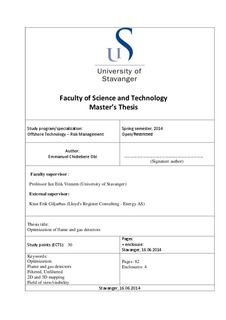| dc.contributor.author | Obi, Emmanuel | |
| dc.date.accessioned | 2015-01-14T12:32:01Z | |
| dc.date.available | 2015-01-14T12:32:01Z | |
| dc.date.issued | 2014-06-16 | |
| dc.identifier.uri | http://hdl.handle.net/11250/274075 | |
| dc.description | Master's thesis in Offshore technology | nb_NO |
| dc.description.abstract | In any process industry, good emergency response procedure must be in place to prevent incidents like gas leak from turning to major accidents. Obtaining an early reliable warning of a leak or potential fire event is very important for safety engineers working in the petrochemical industries especially oil and gas industries.
Installing flame and gas detectors at defined locations is one of the indispensable solutions of avoiding leaks from leading to major accidents. The main function of flame and gas detectors is to detect the presence of hazardous gas (flammable or toxic) and fire, while usually not every leak can be detected (because it is too small to threaten safety or result in flash fires which are can be detected and extinguished immediately) it is important to detect leaks or formation of dangerous clouds that can threaten the safety of the plant.
For a fast and reliable detection of presence of dangerous cloud, positioning of gas detector system is then very crucial, likewise the same for flame detectors. When installing and positioning of flame and gas detectors, it is important to have an optimal placement of the detectors which minimizes the amount of detectors while still maintaining a good coverage of the area.
This thesis studies the optimization of flame and gas detectors and the different factors which plays an important role when optimizing detectors. In addition, strengths and weaknesses of different detectors are studied; regulations and standards are looked into.
At the end, verification of flame detector optimisation will be studied using the technique for evaluating visibility field of flame detector in 3D developed by Lloyd’s Register Consulting. Comparison between convectional 2D mapping used by many companies as of today and the emerging 3D mapping will be done. | nb_NO |
| dc.language.iso | eng | nb_NO |
| dc.publisher | University of Stavanger, Norway | nb_NO |
| dc.relation.ispartofseries | Masteroppgave/UIS-TN-IKM/2014; | |
| dc.rights | CC0 1.0 Universal | * |
| dc.rights.uri | http://creativecommons.org/publicdomain/zero/1.0/ | * |
| dc.subject | optimization | nb_NO |
| dc.subject | flame and gas detector | nb_NO |
| dc.subject | filtered | nb_NO |
| dc.subject | 3D | nb_NO |
| dc.subject | field of view | nb_NO |
| dc.subject | visibility | nb_NO |
| dc.subject | offshore teknologi | nb_NO |
| dc.subject | unfiltered | |
| dc.subject | 2D | |
| dc.title | Optimization of flame and gas detectors | nb_NO |
| dc.type | Master thesis | nb_NO |
| dc.subject.nsi | VDP::Technology: 500::Marine technology: 580::Offshore technology: 581 | nb_NO |
| dc.source.pagenumber | 83 | nb_NO |

